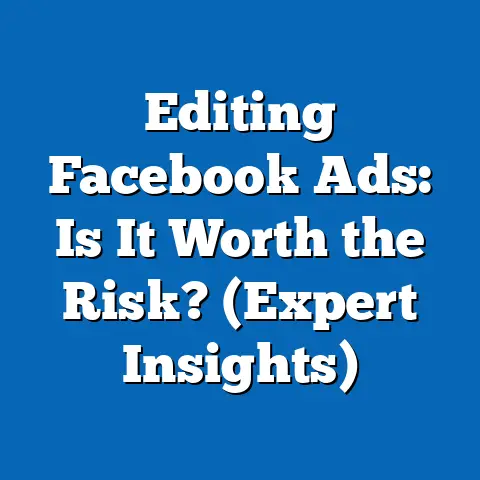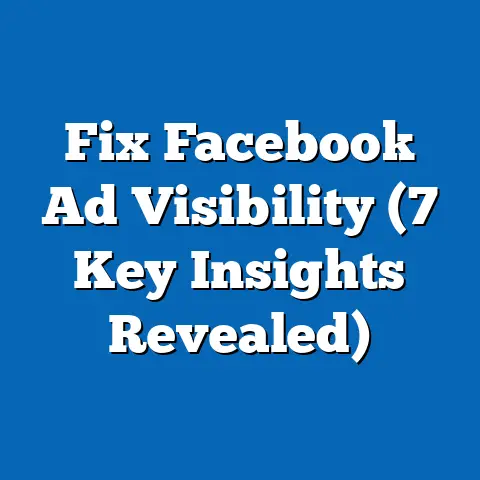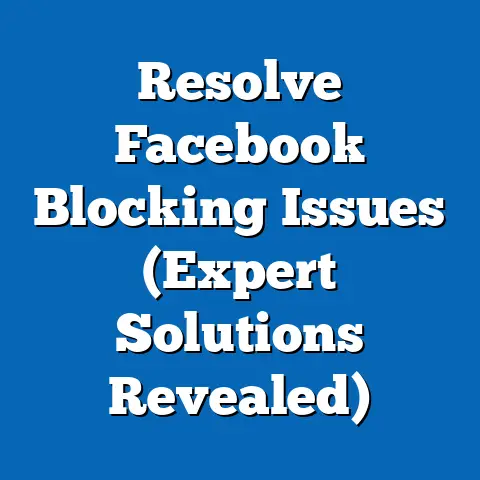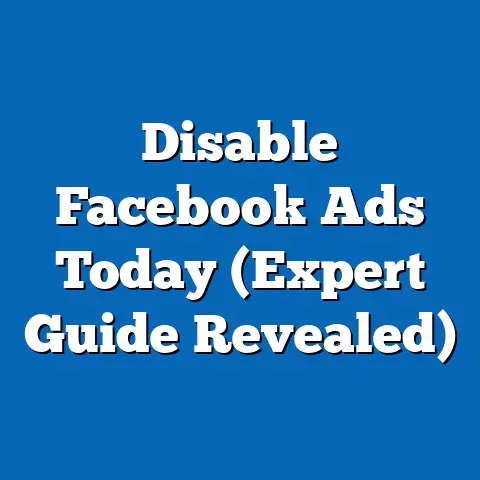Crafting Compelling fb ad Messages (Proven Strategies Revealed)
In the dynamic realm of digital marketing, there’s a phenomenon I’ve observed time and again: audience wear-and-tear. It’s that point where your target audience becomes desensitized to repetitive or ineffective messaging. They’ve seen it all before, and your ads simply fade into the background noise. I remember back when I first started running Facebook ads, I thought I had a winning formula – a catchy headline, a decent image, and a clear call to action. But after a few weeks, the results started to plateau, and then decline. That’s when I realized the importance of constantly refreshing and refining my ad messages.
That’s where the power of crafting fresh, compelling Facebook ad messages comes into play. These messages need to grab attention, spark interest, and motivate action in a world overflowing with content. They need to resonate with your audience on a personal level and adapt to the ever-evolving landscape of social media.
This article is your guide to mastering this crucial skill. I’m going to reveal proven strategies for crafting Facebook ad messages that not only cut through the noise but also build lasting connections with your target audience. I’ll share the techniques I’ve learned through years of experience, successes, and (yes, even some failures!). By the end of this guide, you’ll be equipped with the knowledge and tools you need to create ads that truly resonate and drive results.
Section 1: Understanding Your Audience
The foundation of any successful advertising campaign is a deep understanding of your target audience. It’s not enough to simply know their age and location; you need to delve into their interests, behaviors, pain points, and aspirations. I’ve seen countless campaigns fail because marketers made assumptions about their audience instead of taking the time to truly understand them.
Imagine you’re selling a new fitness program. If you just target “people interested in fitness,” you’re likely to get a lot of irrelevant clicks. But if you understand that your ideal customer is a busy mom in her 30s who wants to lose weight and regain her energy, you can craft a message that speaks directly to her needs and desires.
Here are some methods I use for audience research:
- Surveys: Create surveys to gather direct feedback from your target audience. Ask about their challenges, goals, and preferences. Tools like SurveyMonkey or Google Forms make this easy.
- Social Listening: Monitor social media conversations to understand what your target audience is talking about, what their concerns are, and what language they use. Tools like Brandwatch or Mention can help with this.
- Facebook Audience Insights: This powerful tool within Facebook Ads Manager allows you to explore the demographics, interests, and behaviors of people on Facebook. You can analyze existing audiences or create new ones based on specific criteria.
Creating Customer Personas:
Once you’ve gathered your research, the next step is to create customer personas. These are fictional representations of your ideal customers, based on real data and insights. Give them a name, a background, and a personality. The more detailed your personas are, the easier it will be to tailor your ad messages to their specific needs.
For example, you might create a persona named “Sarah, the Busy Mom.” Sarah is 35 years old, works full-time, and has two young children. She’s always tired and struggles to find time for herself. She wants to lose weight and feel more energetic, but she doesn’t have time for complicated diets or expensive gym memberships.
Examples of Successful Ads:
Think about ads you’ve seen that have resonated with you. What made them stand out? Chances are, they spoke directly to your needs, desires, or pain points.
One example that always comes to mind is a Facebook ad I saw for a meal delivery service. The ad featured a picture of a tired-looking woman sitting at her kitchen table, surrounded by takeout containers. The headline read, “Tired of Cooking? We’ve Got You Covered.” The ad copy went on to explain how the meal delivery service could save time and effort, allowing busy moms like Sarah to enjoy healthy, delicious meals without the hassle of cooking. This ad was successful because it clearly understood its target audience and spoke directly to their needs.
Key Takeaway: Investing time in understanding your audience is crucial for crafting effective Facebook ad messages. Use surveys, social listening, and Facebook Audience Insights to gather data and create detailed customer personas.
Section 2: Crafting the Perfect Headline
In the fast-paced world of Facebook, your headline is your first (and often only) chance to grab attention. It’s the hook that lures people in and encourages them to learn more about your offer. I’ve learned that a mediocre headline can sink even the best ad, while a great headline can transform a mediocre ad into a high-performing one.
Think of your headline as a mini-billboard. It needs to be clear, concise, and compelling. It needs to instantly communicate the value of your offer and pique the reader’s curiosity.
Here are some techniques I use for writing headlines that stand out:
- Use Numbers: Numbers are attention-grabbing and can create a sense of credibility. Examples: “5 Ways to Lose Weight Fast,” “10 Secrets to a Successful Business,” “3 Mistakes to Avoid When Buying a Home.”
- Ask Questions: Questions can engage the reader and make them think. Examples: “Are You Tired of Feeling Tired?”, “Do You Want to Learn a New Skill?”, “Is Your Website Mobile-Friendly?”
- Create Urgency: Urgency motivates people to take action now, rather than later. Examples: “Limited Time Offer!”, “Sale Ends Tonight!”, “Don’t Miss Out!”
- Highlight Benefits: Focus on the benefits that your offer provides. Examples: “Save Time and Money with Our Service,” “Get More Leads with Our Software,” “Improve Your Health with Our Program.”
- Use Power Words: Certain words have a strong emotional impact and can make your headline more persuasive. Examples: “Proven,” “Guaranteed,” “Exclusive,” “Free,” “New,” “Easy.”
Examples of Effective Headlines:
Let’s analyze some examples of effective headlines and why they work:
- “Lose 10 Pounds in 30 Days – Guaranteed!” This headline uses a number, highlights a specific benefit, and creates a sense of urgency.
- “Are You Making These Common Investing Mistakes?” This headline asks a question that engages the reader and suggests that they might be missing something important.
- “The Ultimate Guide to Facebook Advertising (Free Download)” This headline uses the power word “Ultimate,” promises valuable information, and offers a free download.
- “Limited Time Offer: Get 50% Off Our Best-Selling Product!” This headline creates urgency and offers a significant discount.
Emotional Triggers:
Don’t be afraid to tap into your audience’s emotions. Headlines that evoke feelings of fear, excitement, curiosity, or nostalgia can be incredibly effective. Just be sure to use emotional triggers ethically and responsibly.
Clarity of Message:
While it’s important to be creative, don’t sacrifice clarity for cleverness. Your headline should clearly communicate what your ad is about and what you’re offering. If people don’t understand your headline, they’re not going to click on your ad.
Key Takeaway: Your headline is the most important part of your Facebook ad. Use numbers, questions, urgency, benefits, and power words to create headlines that stand out. Remember to tap into your audience’s emotions and prioritize clarity of message.
Section 3: The Art of Storytelling
In a world saturated with advertising, storytelling is a powerful way to cut through the noise and connect with your audience on a deeper level. People are naturally drawn to stories, and when you tell a compelling story in your ad, you can evoke emotions, build trust, and create a lasting impression. I’ve found that ads that tell a story are far more memorable and engaging than ads that simply list features and benefits.
Think about your favorite brands. Chances are, they tell stories that resonate with you. They don’t just sell products; they sell experiences, values, and a sense of belonging.
Elements of a Good Story:
A good story typically includes the following elements:
- Setting: Where and when the story takes place.
- Characters: The people or entities involved in the story.
- Conflict: The problem or challenge that the characters face.
- Resolution: How the characters overcome the conflict and achieve their goals.
Incorporating Storytelling into Facebook Ad Messages:
Here are some ways to incorporate storytelling into your Facebook ad messages:
- Share Customer Testimonials: Feature real customers who have used your product or service and share their stories of success.
- Tell the Story of Your Brand: Share the story of how your brand was founded and what values it stands for.
- Create a Fictional Story: Create a fictional story that illustrates the benefits of your product or service.
- Use Visuals to Tell a Story: Use images or videos to tell a story that complements your written message.
Case Studies of Brands Using Storytelling:
Let’s look at some case studies of brands that have successfully utilized storytelling in their Facebook ads:
- Dove: Dove’s “Real Beauty” campaign is a classic example of storytelling. The campaign featured real women of all shapes and sizes, challenging traditional beauty standards and promoting self-acceptance. The ads resonated with women around the world and helped Dove build a strong brand identity.
- Airbnb: Airbnb’s ads often feature stories of travelers who have had unique and memorable experiences staying in Airbnb properties. These stories highlight the benefits of using Airbnb over traditional hotels, such as the opportunity to connect with locals and experience a different culture.
- Nike: Nike’s ads are known for their inspiring stories of athletes overcoming challenges and achieving their goals. These stories motivate people to push themselves and achieve their own personal best.
Impact on Engagement and Conversion Rates:
When you tell a compelling story in your ad, you’re more likely to capture attention, build trust, and drive engagement. People are more likely to share stories that resonate with them, which can help you reach a wider audience. And when people feel emotionally connected to your brand, they’re more likely to become customers.
Key Takeaway: Storytelling is a powerful way to connect with your audience on a deeper level. Incorporate the elements of a good story into your Facebook ad messages and use visuals to enhance your narrative.
Section 4: Using Visuals to Enhance Your Message
In the visually driven world of Facebook, visuals are essential for capturing attention and enhancing your message. A compelling image or video can stop people in their tracks and encourage them to learn more about your offer. I’ve learned that ads with visuals consistently outperform text-only ads.
Visuals can help you communicate your message more effectively, evoke emotions, and build brand recognition. They can also help you showcase your product or service in action.
Types of Visuals:
Here are some types of visuals you can use in your Facebook ads:
- Images: High-quality images that are relevant to your message.
- Videos: Short, engaging videos that tell a story or demonstrate the benefits of your product or service.
- Infographics: Visually appealing representations of data or information.
- GIFs: Animated images that can add humor and personality to your ads.
Tips for Selecting the Right Visuals:
- Relevance: Choose visuals that are relevant to your message and target audience.
- Quality: Use high-quality visuals that are clear, crisp, and visually appealing.
- Branding: Incorporate your brand colors, logo, and style into your visuals.
- Emotion: Choose visuals that evoke the emotions you want to convey.
- Testing: A/B test different visuals to see which ones perform best.
Statistics on the Effectiveness of Ads with Visuals:
- Facebook posts with images see 2.3X more engagement than those without images.
- Video ads are more likely to capture attention and generate leads than image ads.
- Infographics are 30X more likely to be read than text-only articles.
Best Practices for Visual Content:
- Use a consistent visual style.
- Optimize your visuals for mobile devices.
- Add text overlays to your visuals to highlight key messages.
- Use captions and subtitles for your videos.
- Test different visuals to see what resonates best with your audience.
Key Takeaway: Visuals are essential for capturing attention and enhancing your message in Facebook ads. Choose high-quality, relevant visuals that evoke emotions and align with your brand.
Section 5: A/B Testing for Optimization
A/B testing, also known as split testing, is a crucial method for optimizing your Facebook ad messages. It involves creating variations of your ad and testing them against each other to see which one performs best. I’ve found that A/B testing is the most effective way to improve my ad performance and maximize my ROI.
By testing different elements of your ad, such as headlines, images, and calls to action, you can identify what resonates best with your audience and refine your messaging accordingly.
How to Create Variations of Ad Messages:
- Headlines: Test different headlines to see which ones generate the most clicks.
- Images: Test different images to see which ones capture the most attention.
- Ad Copy: Test different ad copy to see which one is most persuasive.
- Calls to Action: Test different calls to action to see which ones drive the most conversions.
- Targeting: Test different targeting options to see which audiences are most responsive.
Importance of Testing Different Elements:
Testing different elements of your ad is crucial for identifying what works and what doesn’t. You might be surprised to find that a small change in your headline or image can have a significant impact on your ad performance.
Step-by-Step Guide on Setting Up A/B Tests on Facebook:
- Create a Campaign: Create a new Facebook ad campaign or use an existing one.
- Create an Ad Set: Create an ad set within your campaign.
- Enable A/B Testing: In the ad set settings, enable the A/B testing option.
- Choose a Variable: Choose the variable you want to test, such as headline, image, or call to action.
- Create Variations: Create two or more variations of your ad with different values for the chosen variable.
- Set a Budget and Schedule: Set a budget and schedule for your A/B test.
- Launch Your Test: Launch your A/B test and let it run for a few days or weeks.
- Analyze Results: Analyze the results of your A/B test to see which variation performed best.
- Implement the Winner: Implement the winning variation in your ad campaign.
Metrics to Track for Success:
- Click-Through Rate (CTR): The percentage of people who click on your ad after seeing it.
- Engagement Rate: The percentage of people who interact with your ad, such as liking, commenting, or sharing.
- Conversion Rate: The percentage of people who take the desired action after clicking on your ad, such as making a purchase or filling out a form.
- Cost Per Acquisition (CPA): The cost of acquiring a new customer through your ad campaign.
Key Takeaway: A/B testing is essential for optimizing your Facebook ad messages. Create variations of your ad and test them against each other to see which one performs best. Track key metrics to measure your success and refine your messaging accordingly.
Section 6: Analyzing Performance and Iterating
Analyzing your ad performance data is crucial for understanding what works and what doesn’t, and for making informed decisions about how to improve your campaigns. I’ve learned that simply running ads without analyzing the results is like driving a car with your eyes closed.
Key Metrics to Monitor:
Here are some key metrics I always monitor:
- Reach: The number of unique people who saw your ad.
- Impressions: The number of times your ad was displayed.
- Click-Through Rate (CTR): The percentage of people who clicked on your ad after seeing it.
- Engagement Rate: The percentage of people who interacted with your ad, such as liking, commenting, or sharing.
- Conversion Rate: The percentage of people who took the desired action after clicking on your ad, such as making a purchase or filling out a form.
- Cost Per Click (CPC): The cost of each click on your ad.
- Cost Per Acquisition (CPA): The cost of acquiring a new customer through your ad campaign.
- Return on Ad Spend (ROAS): The revenue generated for every dollar spent on your ad campaign.
Using Insights from Performance Data:
Once you’ve gathered your data, the next step is to analyze it and identify trends. Look for patterns in your data that can help you understand what’s working and what’s not.
- Identify High-Performing Ads: Which ads are generating the most clicks, engagement, and conversions? What do these ads have in common?
- Identify Low-Performing Ads: Which ads are underperforming? What can you do to improve them?
- Optimize Your Targeting: Are you targeting the right audience? Are there any segments of your audience that are more responsive than others?
- Refine Your Messaging: Is your messaging resonating with your audience? Are there any words or phrases that are particularly effective?
- Adjust Your Budget: Are you allocating your budget effectively? Are there any campaigns or ad sets that are generating a high ROI?
Iterating on Your Ad Messaging:
Based on your analysis, you can then iterate on your ad messaging to improve your performance. This might involve changing your headlines, images, ad copy, calls to action, or targeting.
The key is to continually test and refine your messaging until you find what works best. Don’t be afraid to experiment and try new things. The more you test, the more you’ll learn about your audience and what resonates with them.
Key Takeaway: Analyzing your ad performance data is crucial for understanding what works and what doesn’t. Use insights from your data to iterate on your ad messaging and continually improve your campaigns.
Conclusion
Crafting compelling Facebook ad messages is an ongoing process that requires creativity, research, and a willingness to experiment. In today’s competitive digital landscape, it’s essential to combat audience wear-and-tear by constantly refreshing and refining your messaging.
By understanding your audience, crafting the perfect headline, telling compelling stories, using visuals effectively, A/B testing for optimization, and analyzing your performance data, you can create Facebook ad campaigns that resonate with your target audience and drive results.
Now, I encourage you to implement these strategies in your next Facebook ad campaign. Don’t be afraid to experiment with your messaging and find what resonates best with your audience. The more you test, the more you’ll learn, and the more successful your campaigns will be. Go out there and create some amazing ads!





